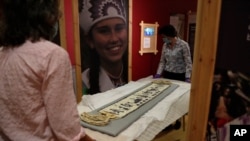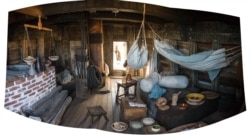Much has been written about the 102 Europeans who crossed the Atlantic aboard the Mayflower in 1620. Much less has been written about the Wampanoag Native American community the Europeans met on the other side. After four centuries, a new exhibition in the place where the ship set sail aims to highlight the largely ignored history of the Wampanoag people.
In the year 1620, the Mayflower left the port of Plymouth in southern England and arrived 10 weeks later in what is now the U.S. state of Massachusetts. The story of the religious separatists and colonists has been well documented over the centuries, unlike the experiences of the Wampanoag Native American community that was already living there.
An exhibition in Plymouth marking the 400-year anniversary of the Mayflower voyage is putting the history of the Wampanoag front and center.
Steven Peters, a citizen of the Wampanoag tribe who is involved in curating the exhibit in Britain, said the arrival of the Mayflower has historically been told from a European point of view.
“We think that once everyone has a chance to listen to all perspectives, and absorb the perspective of both the Europeans and the Native Americans, they can then come to an understanding of what this history was and what those impacts were on the native communities that that unfolding were colonized,” he said.
The arrival of the Mayflower is commonly associated with the American tradition of Thanksgiving celebrations, the first of which was – according to history – in 1621 when Europeans and native Americans joined in celebration. But critics say the traditional Thanksgiving narrative overlooks how the arrival of the settlers ultimately meant loss of land, culture and lives for many Native Americans over the centuries that followed.
Peters said working on projects having to do with the history of his ancestors is part of a difficult journey.
“Often the history and the stories that that we're retelling are tragic and there's a lot of death and sickness. And so, it's emotional for us,” he said.
British curator Jo Loosemore of the Mayflower 400, Legacy and Legend exhibition hopes to fill knowledge gaps.
There is a wealth of information about the maritime journey, the religious perspective and the separatists’ movement. But she said that for most English people the story only begins in 1620.
“What the Wampanoag people have enabled us to see is that the Mayflower certainly wasn't the first ship to cross the Atlantic with traders or settlers or colonists. And also the story most definitely does not begin in 1620 years for the Wampanoag, you're talking a 12,000-year civilization and society, a history and the culture,” she said.
An estimated 30 million Americans can trace an ancestral connection to the Mayflower.








